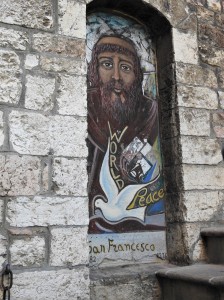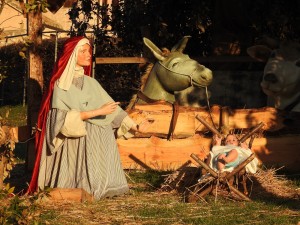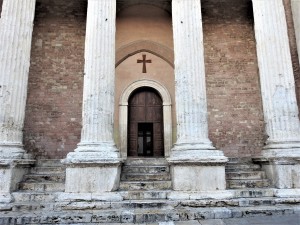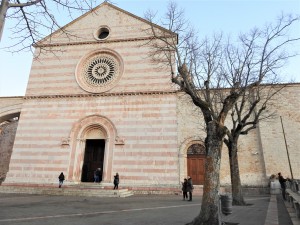Posts Tagged ‘art’
-
AN UNEXPECTED VISIT
 Francis Bernardone came upon the abandoned church of San Damiano in Assisi by accident. He was searching for a place to meditate to find a way forward for his life, when he entered the church and saw a crucifix. As he prayed earnestly in front of it, he heard a voice telling him, “Francis, go and repair my church which, as you see, is all in ruins!” This brief moment changed not only the man’s life but even his birthplace, the Catholic Church, and the lives of many others. An unexpected visit to Assisi proved that the timeless appeal of this instant still prevails.
Francis Bernardone came upon the abandoned church of San Damiano in Assisi by accident. He was searching for a place to meditate to find a way forward for his life, when he entered the church and saw a crucifix. As he prayed earnestly in front of it, he heard a voice telling him, “Francis, go and repair my church which, as you see, is all in ruins!” This brief moment changed not only the man’s life but even his birthplace, the Catholic Church, and the lives of many others. An unexpected visit to Assisi proved that the timeless appeal of this instant still prevails.Dropping by at Assisi for a few hours while exploring the surrounding towns, I found myself getting absorbed in the spiritual atmosphere of this medieval location which has earned its place in the UNESCO list of World Heritage Sites for its influence on religious expression and Europe’s art history. Although it was anticipated that I would visit some churches, I was blown away by the monumental beauty of the basilicas, the medieval character of the town, the intriguing archaeological structures and the boundless feeling of serenity.
The Papal Basilica of St Francis of Assisi dominates the town. It constitutes two churches which are known as the lower and the upper churches. Whereas the lower church is austere and sombre, symbolising the humanity and humility of the saint, the upper church is high vaulted, airy, and widely illuminated to resemble his sanctity and glory. The arcades that line the open square as you approach the basilica were originally used to shelter and feed medieval pilgrims. Nowadays, these offer refuge from the natural elements to the numerous visitors who come to Assisi.
 According to legend, the area on which this basilica was built was originally considered disgraceful since it was a place for public execution. Francis chose it as his burial place because he considered himself as the worst sinner. Today, this blessed location which holds within it the venerated remains of the saint is renowned as the ‘Hill of Paradise’.
According to legend, the area on which this basilica was built was originally considered disgraceful since it was a place for public execution. Francis chose it as his burial place because he considered himself as the worst sinner. Today, this blessed location which holds within it the venerated remains of the saint is renowned as the ‘Hill of Paradise’.The interior of the basilica is an awesome masterpiece which bursts into your senses. Never have I seen such colourful splendour which reaches from top to bottom with frescoes done by leading artists of the 13th century, such as Cimabue, Giotto, Simone Martini, and Pietro Lorenzetti. In contrast, the cruciform crypt of St Francis located deep beneath the two-levelled basilica, is raw and simple. A large open pillar contains the roughly hewn stone sarcophagus which holds the blessed remains of the saint. In the four niches positioned at each angle facing the tomb lie the four disciples of St Francis: fra Leone, fra Masseo, fra Rufino and fra Angelo.
 Even though Christmas celebrations were long over, the Christmas spirit was still very present in Assisi. An exhibition of traditional cribs animated the silent corridors of the friary which is built adjacent to the basilica. Likewise, a large crib with numerous life-size figures gave life to the wide-open area in front of the upper church.
Even though Christmas celebrations were long over, the Christmas spirit was still very present in Assisi. An exhibition of traditional cribs animated the silent corridors of the friary which is built adjacent to the basilica. Likewise, a large crib with numerous life-size figures gave life to the wide-open area in front of the upper church.The main street named after St Francis leads from the basilica to the centre of the town. Like any pilgrimage site, Assisi has become highly commercialized, flooded with souvenir shops which sell all types and all sizes of mementos that depict the saint. Various hotels offer hospitality to the pilgrims and visitors who opt to relish this medieval town’s atmosphere for longer. The elegantly restored 13th century Santa Caterina Monastery, now known as Nun Assisi Relais & Spa Museum, has been turned into a minimalist-styled hotel, and is an unparalleled destination.
 The main square, Piazza del Comune, was always an important point in the town. This is evident by the presence of a Roman temple which is the focal point of the square. Built in the 1st century BC, the imposing temple was originally attributed to the goddess Minerva due to the finding of a female statue. However, recent archaeological discoveries in the area pertaining to other gods have created doubts about which god was honoured by this stately structure. The façade of the temple, with its six huge Corinthian columns supporting the architrave and a small pediment, has now been preserved. The pagan building which is also a UNESCO World Heritage Site serves as a bizarre entrance to the church which it now houses, Santa Maria sopra Minerva.
The main square, Piazza del Comune, was always an important point in the town. This is evident by the presence of a Roman temple which is the focal point of the square. Built in the 1st century BC, the imposing temple was originally attributed to the goddess Minerva due to the finding of a female statue. However, recent archaeological discoveries in the area pertaining to other gods have created doubts about which god was honoured by this stately structure. The façade of the temple, with its six huge Corinthian columns supporting the architrave and a small pediment, has now been preserved. The pagan building which is also a UNESCO World Heritage Site serves as a bizarre entrance to the church which it now houses, Santa Maria sopra Minerva.References to St Francis are present wherever you go in Assisi. Niches, wall paintings, and statues of his parents Pietro di Bernardone and Madonna Pica, continually remind you that this is the birthplace of the saint. Nevertheless, the curious visitor can still encounter offbeat locations such as art galleries, tartufo shops, and traditional cuisine.
 My visit ended at the Basilica of St Clare. Interestingly, the structure of its façade strongly imitates the upper church of the Basilica of St Francis, just how St Clare followed St Francis. Although far from the exuberant quality which one finds in the Basilica of St Francis, this church is still beautifully adorned. The ceiling of the chamber which houses the tomb of St Clare is pleasantly decorated with a blue sky filled with shining stars.
My visit ended at the Basilica of St Clare. Interestingly, the structure of its façade strongly imitates the upper church of the Basilica of St Francis, just how St Clare followed St Francis. Although far from the exuberant quality which one finds in the Basilica of St Francis, this church is still beautifully adorned. The ceiling of the chamber which houses the tomb of St Clare is pleasantly decorated with a blue sky filled with shining stars.The humbler nature of this basilica does not diminish its respect or importance. The Crucifix Chapel located inside protects within it the Byzantine cross which was originally at the ruined church of San Damiano. On the other hand, the Chapel of the Blessed Sacrament occupies the area of the ancient Church of St George, in which both St Francis and St Clare were buried until their basilicas were constructed.
A splendid sunset welcomed me as I stepped out in the square of the Basilica of St Clare from where I could enjoy a fantastic view of the surrounding area. Rocca Maggiore castle hovered over the town and bid me to visit, while at a distance, the Renaissance Basilica of St Mary of the Angels which houses the Porziuncola, the most sacred place for the Franciscans, reminded me that there was so much more to discover.
(This feature was published in the SENIOR TIMES issued with The Times of Malta dated 15th February 2019)
-
Discovering the real art of a new culture
China’s art sector is probably one of the most dynamic today since Chinese artists are constantly re-imagining the boundaries of art as they question their country’s role in the world. These artistic works can be viewed in the several popular art districts, key galleries and museums which are located in various areas around China.
751D Park – Beijing
I had thought that a visit to Beijing would only comprise an itinerary to historical sites. Therefore, this bustling contemporary art centre proved to be quite a surprise.
Having been transformed from an industrial plant into an artistic hub, 751D Park boasts an area of 40,000 square meters and is now a very renowned area for art lovers. Its distinguished Bauhaus-style architecture has succeeded to blend harmoniously with the places’s new character which now houses many art galleries, bookshops, cafes and restaurants.
Although I am not an avid art enthusiast, a stroll around the various shops and art exhibitions of this park served as a portal to another facet of China and its culture. Each outlet provided the opportunity to discover and purchase works of unique styles, original designs and ultimate creativity.
 I was particularly captivated by Liu Fei’s artistic exhibition named ‘An Enchanting War’. The artist described his sharp creations as his contemplation of future wars. Through them, he attempted to engage in social and political life in order to express his distaste and criticism on war. His main theme examined whether future warfare would be a performance of pretences? In his strong and bizarre artworks, there was no boundary between beauty and ugliness, and violence and contention were combined cruelly.
I was particularly captivated by Liu Fei’s artistic exhibition named ‘An Enchanting War’. The artist described his sharp creations as his contemplation of future wars. Through them, he attempted to engage in social and political life in order to express his distaste and criticism on war. His main theme examined whether future warfare would be a performance of pretences? In his strong and bizarre artworks, there was no boundary between beauty and ugliness, and violence and contention were combined cruelly.The National Art Museum of China – Beijing
The National Art Museum of China is dedicated to collection, research and exhibitions of modern and contemporary artistic works in China. Although this structure started to be constructed in 1958 and was open to the public in 1963, its architecture features the traditional Chinese style as the main building is roofed with yellow glazed tiles and surrounded by corridors and pavilions.
This museum covers an area of more than 18,000 square meters and it includes 17 exhibition halls throughout its 5 storeys. It prides itself with more than 100,000 pieces of various collections, most of which are representative works of different periods and great artworks of Chinese art masters from the end of the 19th century till today.
 Since its establishment, this national museum has organized thousands of various artistic exhibitions which reflect the development of Chinese art. These activities have attracted millions of visitors each year and so this museum has also served as a significant platform for the artists involved.
Since its establishment, this national museum has organized thousands of various artistic exhibitions which reflect the development of Chinese art. These activities have attracted millions of visitors each year and so this museum has also served as a significant platform for the artists involved.During my visit, amongs its selection of expositions, this museum was holding the exhibition ‘Beautiful China: Call of Humanism’ which entailed the First National Fine Art Exhibition to help the disabled. The ensemble of 200 pieces of artworks included masterpieces of top artists of the contemporary art world,as well as works of disabled calligraphers and painters. Funds from the sales of these artworks were collected in order to assist the needs of the thousands of disabled Chinese individuals.
M50 – Shanghai
50 Moganshan Road or M50 art district as it is more popularly known, was a former textile mill in central Shanghai which has now been converted into a major zone of artistic galleries and exhibition spaces.
This quarter started to become popular with artists in the year 2000 when the first individuals were initially attracted by the cheap rent of the disused industrial space. Soon, other artists followed suit and nowadays this complex has become known for its trendy and high art quality.
 Art lovers who visit this place get a chance to enjoy and purchase some fantastic and unusual works directly from the artists themselves. The allure of this zone lies in the variety of displayed works using several mediums.Prices range from affordable to really expensive but one is expected to negotiate.
Art lovers who visit this place get a chance to enjoy and purchase some fantastic and unusual works directly from the artists themselves. The allure of this zone lies in the variety of displayed works using several mediums.Prices range from affordable to really expensive but one is expected to negotiate.Popular with both local and international visitors, this art quarter is unpretentious but interesting and often thought provoking. Amongst the wide selection of creations, it is engaging to notice also some works of a rebellious nature.
(This article was published in the Travel, Leisure and Food Supplement in the Sunday Times of Malta dated 15 March 2015)
Travelogue
Archives
| M | T | W | T | F | S | S |
|---|---|---|---|---|---|---|
| « Jan | ||||||
| 1 | 2 | 3 | 4 | 5 | 6 | 7 |
| 8 | 9 | 10 | 11 | 12 | 13 | 14 |
| 15 | 16 | 17 | 18 | 19 | 20 | 21 |
| 22 | 23 | 24 | 25 | 26 | 27 | 28 |
| 29 | 30 | |||||
Recent Posts
- A MATTER OF FATE
- MALTA’S PREHISTORIC TREASURES
- THE MAGIC IS IN THE DETAIL
- THE SELLING GAME
- NEVER FORGOTTEN
- Ġrajjiet mhux mitmuma – 35 sena mit-Traġedja tal-Patrol Boat C23
- AN UNEXPECTED VISIT
- THE SISTERS OF THE CRIB
Comments
- Pauline Harkins on Novella – Li kieku stajt!
- admin on IL-KARNIVAL TRAĠIKU TAL-1823
- Albert on IL-KARNIVAL TRAĠIKU TAL-1823
- Martin Ratcliffe on Love in the time of war
- admin on 24 SENA ILU: IT-TRAĠEDJA TAL-PATROL BOAT C23